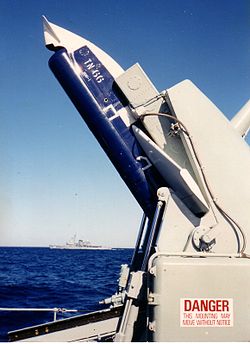Ikara missile
| Ikara | |
|---|---|

Ikara missile on launcher
|
|
| Type | Anti-submarine |
| Place of origin | Australia |
| Service history | |
| In service | 1960s–1990s |
| Used by | Australia Brazil Chile New Zealand United Kingdom |
| Production history | |
| Designed | Circa 1959–60 |
| Manufacturer | Australian Government Aircraft Factories/Commonwealth Aircraft Corporation (CAC)/Australian Defence Scientific Services (ADSS) |
| Produced | Early 1960s |
| Specifications | |
| Weight | 513 kilograms (1,131 lb) |
| Length | 3.429 metres (135.0 in) |
| Warhead |
Mark 44 (two versions) Mark 46 NDB (Nuclear Depth Bomb). |
|
Detonation
mechanism |
none |
|
|
|
| Engine | Bristol Aerojet Murawa two-stage solid-fuel rocket engine. |
| Wingspan | 1.524 metres (60.0 in) |
|
Operational
range |
Maximum range: 10 nautical miles (19 km) Minimum (safety) range: 914 metres (1,000 yd) |
| Flight ceiling | 335 metres (1,099 ft) |
| Speed | Boost max: 713 kilometres per hour (443 mph) Cruise: 658 kilometres per hour (409 mph) Maximum boost acceleration: 10.9G Boost burn time: 1.96 seconds Launcher maximum elevation: 55° Maximum range time interval: 100 sec. |
|
Guidance
system |
Command guidance |
|
Steering
system |
Elevons |
|
Launch
platform |
Ship-borne |
The Ikara missile was an Australian ship-launched anti-submarine missile, named after an Australian Aboriginal word for "throwing stick". It launched an acoustic torpedo to a range of 10 nautical miles (19 km), allowing fast-reaction attacks against submarines at ranges that would otherwise require the launching ship to close for attack, placing itself at risk. Also, by flying to the general area of the target, the engagement time was dramatically reduced, giving the target less time to respond. Submariners referred to IKARA as "Insufficient Knowledge And Random Action".
With the development of nuclear power, submarine performance, especially speed, improved dramatically, as did the threat they posed. Simultaneously, sonar detection capability at long range was also improving significantly but the weapons available to surface escort warships were still of the short-range variety. The final British development of the A/S mortar was the Limbo mortar, able to fire in all directions but limited to a maximum range of 914 metres (2,999 ft). Even the latest modern Mark 46 lightweight torpedoes are limited in range to 4 nautical miles (7.4 km), and at their speed of 28 knots (52 km/h) would take 8.5 minutes to travel that distance, and are consequently unable to attack time-urgent targets at extended ranges.
Known initially under the rainbow code name Blue Duck, the Ikara was a "Rocket-Thrown-Weapon" with similarities to the French Malafon. It differed from Malafon, in that the torpedo was semi recessed in the body of missile body rather than mounted in the nose. Ikara's range at 10 nautical miles (19 km) was double that of ASROC. Ikara was generally considered a superior system to ASROC as it was accurately guided during flight to ensure optimal targeting. A submarine would be aware from sonar contacts that it was about to be attacked and could engage in evasive changes of course. In ASROC's flight time to maximum range of 55 seconds, a submarine travelling at 25 knots (46 km/h) would move 700 metres (2,300 ft) from its position at launch, and a prediction would be made of the submarine's likely position at torpedo splashdown. But during the design of Ikara around 1960 the range of the acoustic seeker of the Mk.44 torpedo was limited to 457 metres (1,499 ft) and consequently its kill probability was low. The range of the acoustic seeker was later improved.
...
Wikipedia
